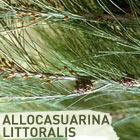If you want to make a difference to the environment it is critical to have some local native plants in your garden. Don planted she oaks in his garden to attract native birds. They have woody, barrel-shaped cones containing winged seeds, which birds like glossy black cockatoos and red-browed finches love to eat. Willie wagtails, pee wees and butcherbirds all favour she oaks as nesting trees. She oaks come in a variety of sizes, from ground covers through to shrubs and trees. Many species have adapted to tolerate wet conditions, dry climates, swamp areas and coastal regions.
Forest oak or rose oak (Allocasuarina torulosa)
In many areas of Australia glossy black cockatoos feed exclusively on the forest oak. It is a graceful tree to around 15m (50′) tall. In autumn and winter the fine, drooping branchlets turn a rich burgundy colour, contrasting with the young green foliage and deeply furrowed bark. This tree grows best in the warmer areas of Australia.
Black she-oak (Allocasuarina littoralis)
Another favourite with glossy black cockatoos is the black she oak, an evergreen tree to around 10m (30’) tall with an erect form and fine, dark green foliage. The bark is grey-brown and closely fissured. Female trees produce clusters of narrow, cylindrical cones, while flower spikes give male trees a reddish tint in winter. Black she oaks grow best in warm coastal climates and are often found close to the sea.



